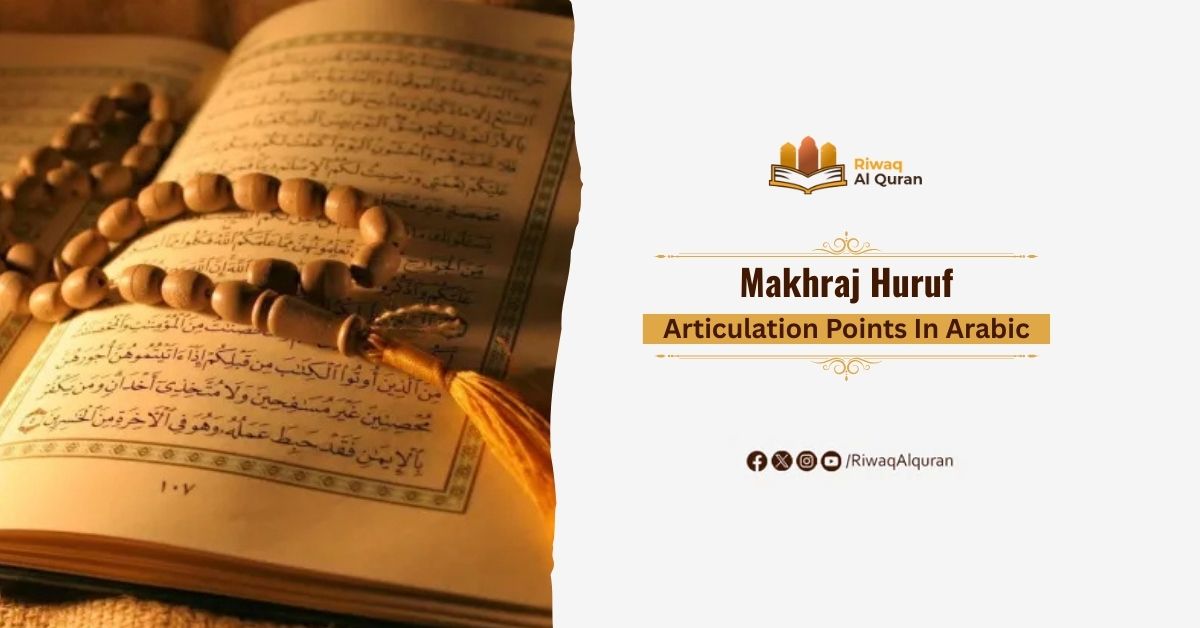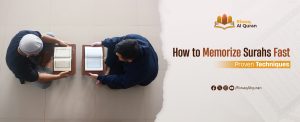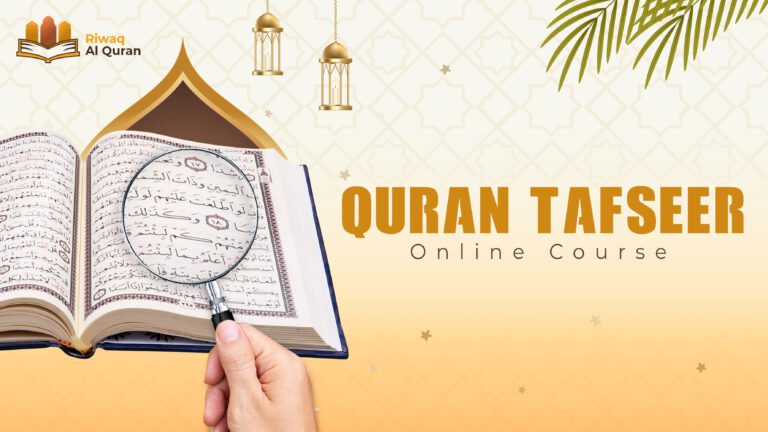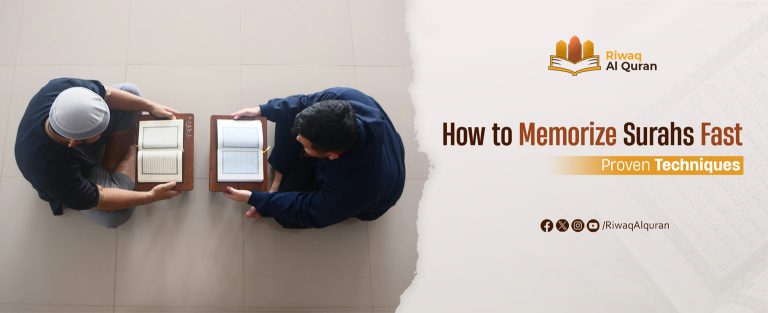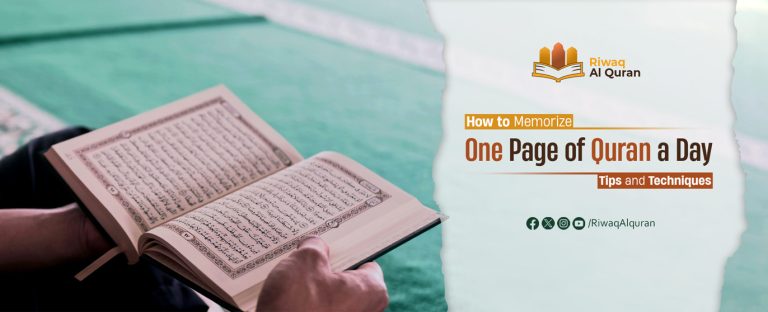Arabic is renowned for its phonemic richness, particularly evident in its detailed system of Makhraj Huruf (articulation points) [Arabic: مخارج الحروف]. A truly distinctive feature of Arabic is that it employs a remarkably broad spectrum of the vocal apparatus, from the lips to the glottis. This extensive use contributes to its unique phonetic character. That’s why it is a critical topic to study.
In this article, we will tackle the meaning of Makhraj Huruf with examples. Then, we will see how to know the correct Makhraj (point of articulation) of each Arabic letter. After that, we will explore, in some detail, the main Makhraj Huruf (articulation points) in Tajweed, which are five. Finally, we will discuss why it is important to learn and master the articulation points of Arabic letters.
Table of Contents
What Is The Meaning Of Makhraj Huruf?
Makhraj Huruf refers to the articulation points of Arabic letters—the precise locations in the human vocal apparatus (oral cavity, throat, tongue, lips, etc.) where each letter’s sound originates. Proper pronunciation (Tajweed) of the Quran and classical Arabic depends on mastering these points of articulation to ensure clarity and correctness.
However, some Arabic letters have very close articulation points, such as ق and ك. They are both produced from the furthest back of the tongue. However, the articulation point of one of them (ق) is a bit further than that of the other (ك). This is crucial to learn and put into practice; otherwise, it may lead to major errors that could alter meanings (e.g., the words قلب [heart] and كلب [dog] only differ in the articulation points of ق and ك).
How To Know The Correct Makhraj Of Any Letter?
The easiest way to check where the articulation point of an Arabic letter is by doing two steps:
1- Make the letter Sakin, i.e, do not give it any Haraka: Fatha [الفتحة] (َ), Damma [الضمة] (ُ) or Kasra [الكسرة] (ِ).
2- Put Hamzatul Waṣl (همزة الوصل) before the letter.
For example, to check the articulation point of the letter “ل”, you need to make it Sakin and put a Hamzatul Waṣl before it and say it as “ال”. When you do so, you will see that the articulation point of “ل” is the tip of the tongue.

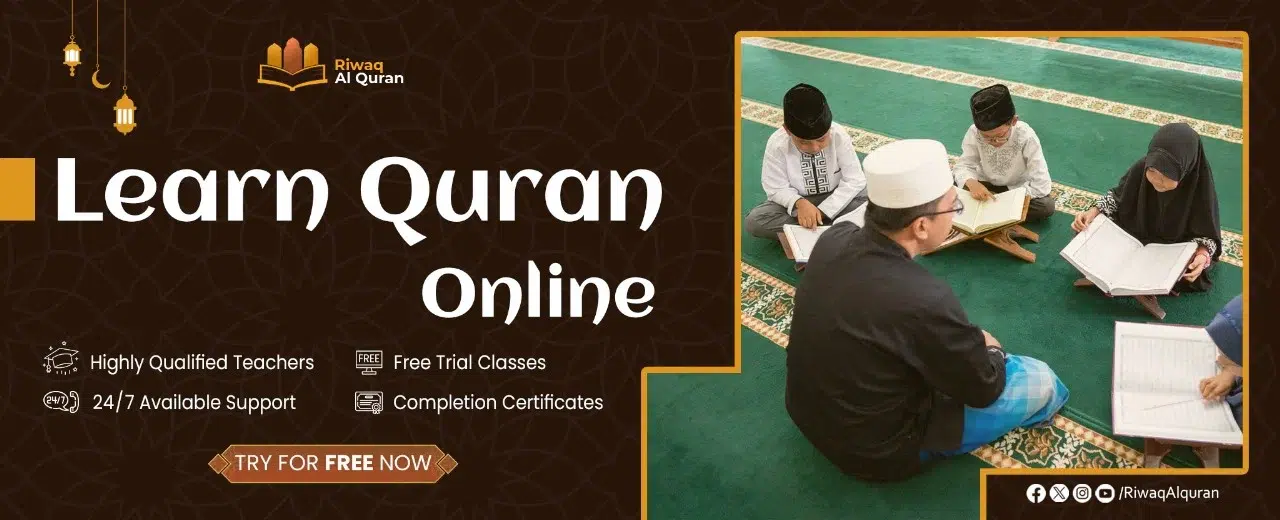
What Are Makhraj Huruf (Articulation Points) In Tajweed?
In Arabic phonology, letters are produced from 17 specific articulation points grouped into five major articulation zones. Let’s see these, in detail, with some examples.
1. Oral Cavity (الجوف):
This articulation point (or zone) has to do with the three Madd (elongation) letters only. These letters move freely through the oral cavity and have no specific points where they are produced.
| Specific point of articulation | Letters | Sound Production | Example |
| Empty mouth/throat | ا، و، ي | Prolonged vowel echoes (like humming) | “قَالُوٓا۟ ءَامَنَّا بِرَبِّ ٱلْعَـٰلَمِينَ”(The Quran, 26:47)In this verse, the Madd letters و, ا and ي come from the oral cavity. |
2. Throat (الحلق):
This is the articulation point of 6 Arabic letters: أ, هـ, ع, ح, غ, and خ.
| Specific point of articulation | Letters | Sound Production | Example |
| The furthest point of the throat | أ – هـ | Whisper from throat’s base | “إِنَّ هَـٰٓؤُلَآءِ لَشِرْذِمَةٌۭ قَلِيلُونَ”(The Quran, 26:54)In this verse, the letters إ and هـ come from the furthest point of the throat. |
| The Middle point of the throat | ح – ع | Raspy friction (like clearing throat) | “وَٱللَّهُ عَلِيمٌ حَكِيمٌۭ”(The Quran, 22:52)In this part of the verse, the letters ع and ح come from the Middle point of the throat. |
| The closest point of the throat | غ – خ | Guttural (like gargling water) | “خَـٰلِدِينَ فِيهَا لَا يَبْغُونَ عَنْهَا حِوَلًۭا”(The Quran: 18:108)In this verse, the letters غ and خ come from the closest point of the throat. |
3. Tongue (اللسان):
The tongue plays the dominant role in Arabic articulation, serving as the primary Makhraj (articulation point) for 18 out of 28 Arabic letters. Let’s break it down below:
| Specific point of articulation | Letters | Sound Production | Example |
| Furthest back of the tongue | ق ك | The furthest back tongue touches the soft palate.(ك comes from a somewhat closer point than ق) | “قُل لَّوْ كَانَ ٱلْبَحْرُ مِدَادًۭا لِّكَلِمَـٰتِ رَبِّى لَنَفِدَ ٱلْبَحْرُ قَبْلَ أَن تَنفَدَ كَلِمَـٰتُ رَبِّى وَلَوْ جِئْنَا بِمِثْلِهِۦ مَدَدًۭا”(The Quran, 18:109) All the letters ق and ك in this verse come from the furthest back of the tongue (ك comes from a somewhat closer point than ق). |
| Middle of the tongue | ج – ش – ي | The middle tongue touches the palate of the mouth. | “حَتَّىٰٓ إِذَا بَلَغَ مَغْرِبَ ٱلشَّمْسِ وَجَدَهَا تَغْرُبُ فِى عَيْنٍ حَمِئَةٍۢ وَوَجَدَ عِندَهَا قَوْمًۭا ۗ قُلْنَا يَـٰذَا ٱلْقَرْنَيْنِ إِمَّآ أَن تُعَذِّبَ وَإِمَّآ أَن تَتَّخِذَ فِيهِمْ حُسْنًۭا”(The Quran: 18:86)In the verse, all the letters ج, ش and ي come from the middle of the tongue. |
| Side of the tongue | ض | Side tongue presses upper molars (unique to Arabic). That’s why Arabic is called “the language of the ض sound” [لغة الضاد]. | “…وَلَا ٱلضَّآلِّينَ”(The Quran, 1:7)Here, the ض sound comes from the side of the tongue [the left side is much easier to use than the right side]. |
| Tip of the tongue | ل ن ر | The tip of the tongue touches the gum behind the front teeth.The tip of the tongue vibrates lightly with Ghunnah.The tip of the tongue flips rapidly (rolled “r”). | “أُو۟لَـٰٓئِكَ ٱلَّذِينَ لَيْسَ لَهُمْ فِى ٱلْـَٔاخِرَةِ إِلَّا ٱلنَّارُ…”(The Quran: 11:16)Here, the letter ل, ن and ر come from the tip of the tongue. |
| Tip of the tongue and the Teeth | د – ت – ط ص – س- ز ث – ذ – ظ | The tip of the tongue touches the upper teeth/gumThe tip of the tongue comes very close to the upper teeth, without touching them.The tip of the tongue protrudes slightly between teeth. | “…وَمَآ أَنَا۠ بِطَارِدِ ٱلَّذِينَ ءَامَنُوٓا۟ ۚ إِنَّهُم مُّلَـٰقُوا۟ رَبِّهِمْ وَلَـٰكِنِّىٓ أَرَىٰكُمْ قَوْمًۭا تَجْهَلُونَ”(The Quran, 11:29) “ٱلَّذِينَ يَصُدُّونَ عَن سَبِيلِ ٱللَّهِ…”(The Quran, 11:19) “وَمَنْ أَظْلَمُ مِمَّنِ ٱفْتَرَىٰ عَلَى ٱللَّهِ كَذِبًا…”(The Quran, 11:8) |
4. Lips (الشفتان):
Lips represent the articulation point of 4 Arabic letters: ب, م, و and ف. Let’s see these four below.
| Specific point of articulation | Letters | Sound Production | Example |
| Lips pressed | ب – م | Full lip closure | “وَقَالَ ٱرْكَبُوا۟ فِيهَا بِسْمِ ٱللَّهِ مَجْر۪ىٰهَا وَمُرْسَىٰهَآ”(The Quran, 11:41) |
| Lips rounded/touching teeth | و – ف | Partial closure or the teeth on the lower lip | “فَلَمَّا جَآءَ أَمْرُنَا نَجَّيْنَا صَـٰلِحًۭا وَٱلَّذِينَ ءَامَنُوا۟ مَعَهُۥ”(The Quran, 11:66) |
5. Nasal Cavity (الخيشوم):
This is the c of the Ghunnah of the three nasal sounds: ن, م and Tanween. Let’s break it down below:
| Specific point of articulation | Letters | Sound Production | Example |
| Nasal passage | ن – م and Tanween sound (with Ghunnah) | Air flows through the nose (humming sound) | “نَجَّيْنَا صَـٰلِحًۭا وَٱلَّذِينَ ءَامَنُوا۟ مَعَهُۥ بِرَحْمَةٍۢ مِّنَّا وَمِنْ خِزْىِ يَوْمِئِذٍ”(The Quran: 11:66) |
Read Also: Huroof Al Muqatta’at In Tajweed
Why Is It Important To Study Makhraj Huruf?
Studying Makhraj Huruf is essential for several key reasons, particularly in Quranic recitation, linguistic accuracy, and cultural preservation. Here’s why it matters:
1- Divine Preservation:
The Quran was revealed in Arabic, and Allah commands its recitation with Tajweed [“وَرَتِّلِ ٱلْقُرْءَانَ تَرْتِيلًا” (recite the Quran ˹properly˺ in a measured way) (Quran, 73: 4)]. Proper Makhraj ensures the text remains unchanged in sound and meaning.
2- Avoiding Meaning Errors:
Mispronouncing a single letter can alter a word’s meaning, leading to theological misunderstandings.
Let’s see the following example:
“فَلَا يَصُدَّنَّكَ عَنْهَا مَن لَّا يُؤْمِنُ بِهَا وَٱتَّبَعَ هَوَىٰهُ فَتَرْدَىٰ”
[So do not let those who disbelieve in it and follow their desires distract you from it, or you will be doomed.]
In this verse, if the reciter pronounces the د of “فَتَرْدَىٰ” [English: or you will be doomed] from the articulation point of the ض sound, the word perceived will be “فَتَرْضَىٰ” [English: or you will be pleased]. This is the complete opposite. Here is a great example of how giving the wrong articulation point can give a different and sometimes the opposite meaning while reciting the Quran.
Read Also: Laam Alif With Examples – Full Guide
3- Preserving The Authentic Sound Of Arabic:
Letters like ض, ع, and غ have no equivalents in other languages. Mastering their Makhraj preserves Arabic’s phonetic richness.
4- Phonetic Clarity:
Mastering Makhraj Huruf enables an Arabic reader/reciter to distinguish between similar letters (e.g., ح versus هـ, or ص versus س).
5- Professional Needs:
Proficiency in Makhraj Huruf is essential for careers in fields such as Quranic education, Islamic scholarship, Arabic linguistics, speech therapy, broadcasting, and voice acting.
Read Also: Quran Alphabet And Tajweed Letters Pronunciation With Examples
6- Reward for Tajweed:
Prophet Muhammad (peace be upon him) emphasized the beautification of the Quran’s recitation. This is achieved through proper Makhraj Huruf, which elevates one’s recitation.
In this regard, Prophet Muhammad (peace be upon him) said:
.”الذي يقرأ القرآن وهو ماهر به مع السفرة الكرام البررة، والذي يقرأ القرآن ويتتعتع فيه وهو عليه شاق له أجران”
[The one who is proficient in the recitation of the Quran will be with the honorable and obedient scribes (angels) and he who recites the Quran and finds it difficult to recite, doing his best to recite it in the best way possible, will have two rewards.](Al-Bukhari and Muslim)
Read Also: Sifaat Al Huroof In Tajweed


Learn Quran, Arabic And Islamic Studies Online With The Best Native Tutors
Riwaq Al Quran is a comprehensive online platform that offers personalized Quran, Arabic and Islamic Studies Online classes for individuals of all ages and backgrounds.
Their experienced instructors use a structured curriculum to cover Tajweed, Tafsir, and Memorization, providing easy and effective access to learning the Quran.
The advanced online classes allow for seamless communication and interaction between students and teachers. Join Riwaq Al Quran for a deeper connection with the Quran.
We offer several courses such as:
- Online courses for kids.
- Online Quran classes for kids and adults.
- Online Arabic courses
- Online Ijazah courses
- Online Islamic Studies courses.
Here are a sample of our set of Quran Courses that will be helpful for you:
- Online Tafseer Course: Delve into Quranic meanings with our insightful online Tafseer course.
- Noorani Qaida Online: Learn Quranic basics efficiently through our Noorani Qaida online program.
- Online Quran Recitation Course: Enhance Quranic recitation skills through our expert-led online course.
- Online Tajweed Classes: Master Tajweed rules for beautiful Quranic recitation in online classes.
- Quran Memorization Online Course: Memorize the Quran effectively with our specialized online memorization course.
- Online Qirat Course: Explore diverse Qirat styles with our comprehensive online Qirat course.
- Online Quran Classes for Kids: Nurture a love for the Quran in kids through interactive online classes.
Conclusion
To sum up, Makhraj Huruf is critical in Arabic phonology in general and in the Quran recitation (Tarteel) in particular. Mastering Makhraj Huruf is not just about pronunciation—it is about honoring the language of the Quran and connecting deeply with Arabic’s divine and cultural heritage. It is a journey that demands dedication, patience, and consistent practice—and the reward is undoubtedly well-deserved.

